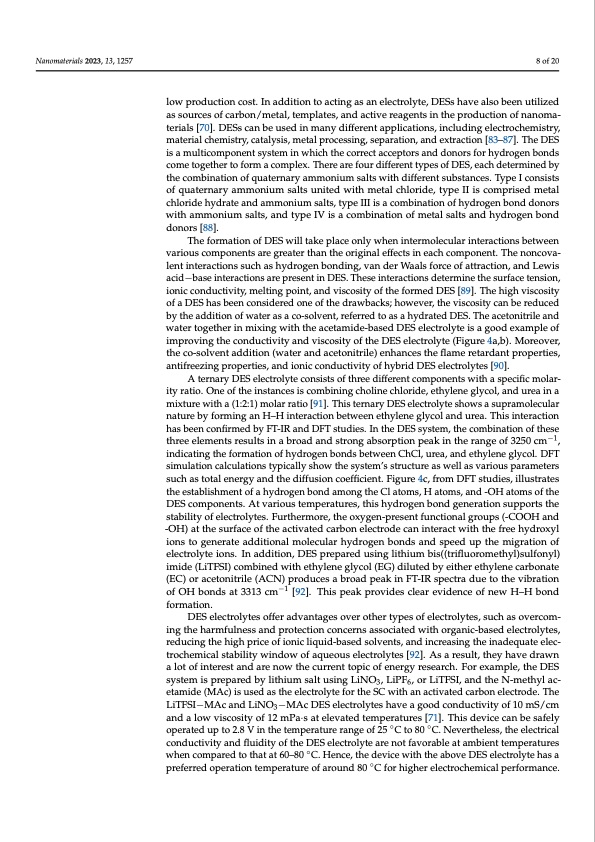
PDF Publication Title:
Text from PDF Page: 008
Nanomaterials 2023, 13, 1257 8 of 20 low production cost. In addition to acting as an electrolyte, DESs have also been utilized as sources of carbon/metal, templates, and active reagents in the production of nanoma- terials [70]. DESs can be used in many different applications, including electrochemistry, material chemistry, catalysis, metal processing, separation, and extraction [83–87]. The DES is a multicomponent system in which the correct acceptors and donors for hydrogen bonds come together to form a complex. There are four different types of DES, each determined by the combination of quaternary ammonium salts with different substances. Type I consists of quaternary ammonium salts united with metal chloride, type II is comprised metal chloride hydrate and ammonium salts, type III is a combination of hydrogen bond donors with ammonium salts, and type IV is a combination of metal salts and hydrogen bond donors [88]. The formation of DES will take place only when intermolecular interactions between various components are greater than the original effects in each component. The noncova- lent interactions such as hydrogen bonding, van der Waals force of attraction, and Lewis acid−base interactions are present in DES. These interactions determine the surface tension, ionic conductivity, melting point, and viscosity of the formed DES [89]. The high viscosity of a DES has been considered one of the drawbacks; however, the viscosity can be reduced by the addition of water as a co-solvent, referred to as a hydrated DES. The acetonitrile and water together in mixing with the acetamide-based DES electrolyte is a good example of improving the conductivity and viscosity of the DES electrolyte (Figure 4a,b). Moreover, the co-solvent addition (water and acetonitrile) enhances the flame retardant properties, antifreezing properties, and ionic conductivity of hybrid DES electrolytes [90]. A ternary DES electrolyte consists of three different components with a specific molar- ity ratio. One of the instances is combining choline chloride, ethylene glycol, and urea in a mixture with a (1:2:1) molar ratio [91]. This ternary DES electrolyte shows a supramolecular nature by forming an H–H interaction between ethylene glycol and urea. This interaction has been confirmed by FT-IR and DFT studies. In the DES system, the combination of these three elements results in a broad and strong absorption peak in the range of 3250 cm−1, indicating the formation of hydrogen bonds between ChCl, urea, and ethylene glycol. DFT simulation calculations typically show the system’s structure as well as various parameters such as total energy and the diffusion coefficient. Figure 4c, from DFT studies, illustrates the establishment of a hydrogen bond among the Cl atoms, H atoms, and -OH atoms of the DES components. At various temperatures, this hydrogen bond generation supports the stability of electrolytes. Furthermore, the oxygen-present functional groups (-COOH and -OH) at the surface of the activated carbon electrode can interact with the free hydroxyl ions to generate additional molecular hydrogen bonds and speed up the migration of electrolyte ions. In addition, DES prepared using lithium bis((trifluoromethyl)sulfonyl) imide (LiTFSI) combined with ethylene glycol (EG) diluted by either ethylene carbonate (EC) or acetonitrile (ACN) produces a broad peak in FT-IR spectra due to the vibration of OH bonds at 3313 cm−1 [92]. This peak provides clear evidence of new H–H bond formation. DES electrolytes offer advantages over other types of electrolytes, such as overcom- ing the harmfulness and protection concerns associated with organic-based electrolytes, reducing the high price of ionic liquid-based solvents, and increasing the inadequate elec- trochemical stability window of aqueous electrolytes [92]. As a result, they have drawn a lot of interest and are now the current topic of energy research. For example, the DES system is prepared by lithium salt using LiNO3, LiPF6, or LiTFSI, and the N-methyl ac- etamide (MAc) is used as the electrolyte for the SC with an activated carbon electrode. The LiTFSI−MAc and LiNO3−MAc DES electrolytes have a good conductivity of 10 mS/cm and a low viscosity of 12 mPa·s at elevated temperatures [71]. This device can be safely operated up to 2.8 V in the temperature range of 25 ◦C to 80 ◦C. Nevertheless, the electrical conductivity and fluidity of the DES electrolyte are not favorable at ambient temperatures when compared to that at 60–80 ◦C. Hence, the device with the above DES electrolyte has a preferred operation temperature of around 80 ◦C for higher electrochemical performance.PDF Image | Water-in-Salt Eutectic Solvent-Based Liquid Electrolytes

PDF Search Title:
Water-in-Salt Eutectic Solvent-Based Liquid ElectrolytesOriginal File Name Searched:
nanomaterials-13-01257.pdfDIY PDF Search: Google It | Yahoo | Bing
Salgenx Redox Flow Battery Technology: Power up your energy storage game with Salgenx Salt Water Battery. With its advanced technology, the flow battery provides reliable, scalable, and sustainable energy storage for utility-scale projects. Upgrade to a Salgenx flow battery today and take control of your energy future.
| CONTACT TEL: 608-238-6001 Email: greg@infinityturbine.com | RSS | AMP |